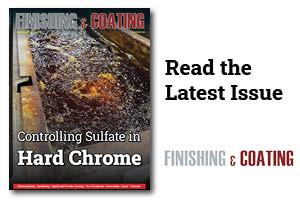The electroplater will be more successful when familiar with some basic math skills.
 Eric Svenson SrIt’s human nature to make assumptions, sometimes wrong ones, and these lead to imperfect deposits, reduced production and lost profits. Having the ability to make some basic calculations will go a long way towards improving the plating operation.
Eric Svenson SrIt’s human nature to make assumptions, sometimes wrong ones, and these lead to imperfect deposits, reduced production and lost profits. Having the ability to make some basic calculations will go a long way towards improving the plating operation.
Our purpose isn’t making the plater into a mathematician, but to provide them with the basic skills needed to make their job easier and their production run more efficiently. This will be especially valuable for the production supervisor and the lead-plater. Some of the calculations they should be familiar with include:
- Tank volume
- Part surface area
- Current density
- Rectifier Setting
- Plating Speed
- Deposit Thickness
- Plating Time
- Anode Area
- Anode-cathode ratio
- Bath additions
- Metal conductivity
The electroplater should be able to calculate these points accurately if they expect any degree of success in their trade. They may also be required to perform conversions in unit sizes and between the imperial and metric systems of measurement. This is because the measurements on the prints and specifications they work from often vary. Following are formulas for the commonly used calculations in electroplating.
Tank Volume
We start by making an accurate calculation of the tank volumes used in the plating system This is critical if precise bath additions are expected. As an example, a particular operation might think their tank is 1,200 gallons and that volume has been on their record for decades. But when you actually measure the tank, it turns out to be 1,440 gallons, or some other volume. This is a very common mistake in the plating industry, perhaps based on an assumption, but nobody actually measured the tank and calculated its working volume.
That error makes a huge difference when making chemical additions or a new bath make-up. Every tank should be measured in inches on its interior dimensions (within +/- 1/8”) with a tape measure. Also note the solution level, i.e.: the distance from the tank’s top rim to the liquid’s typical operating level.
Measuring in inches is much more accurate than measuring in feet. This calculation is based on a U.S. gallon containing 231 cubic inches. There is no need for using a decimal point for the tank volume calculation unless the tank is extremely small, so we typically round the decimal to the next closest whole number. The calculations and examples for both rectangular and round tanks are:
Rectangular Tanks
- Calculation: Length x width x (depth – solution level) / 231
- Example: Length = 96”, Width = 36”, Depth = 72”, Solution Level = 4”
- Bath volume = 1,017 gallons
- [96 x 36 x 68 (72-4)] / 231 = 1,017 gallons
Round Tanks
- Calculation: Radius² x π x (depth – solution level) / 231
- The radius is 1/2 the diameter; square this by multiplying it by itself; pi π is 3.1416
- Example: Diameter = 48”, Depth = 120”, Solution Level = 4”
- Bath volume = 909 gallons
- [(24 x 24) x 3.1416 x (120 – 4)] / 231 = 909 gallons
Part Surface Area
The plater should be able to calculate the surface area of the parts being plated. This is important so they can then determine the total tank loading and therefore the rectifier setting once the ideal current density is determined. Determining the surface area of round and rectangular parts is as follows:
Cylindrical Shafts
This formula doesn’t include the top and bottom surfaces as these areas don’t normally get plated. If these areas do get plated use the Disc calculations below and add that to the shaft area.
- Calculation: Diameter x π x height; pi π is 3.1416
- Example: Diameter = 4”, Height = 72”
- Part Surface Area = 905 square inches
- 4 x 3.1416 x 72 = 905
Square & Rectangular Shapes
- Calculation: Length x height
- Example: Length = 24”, Height = 18”
- Part Surface Area = 432 square inches
- 24 x 18 = 432
These formulas calculate the area of only one side, double this if plating both sides. Also calculate the edges if they are thick and also get plated, using the same formula. Then add this to the front and back areas to determine the total plated area.
Discs (round circles)
- Calculation: Radius² x π; the radius is 1/2 the diameter and pi π is 3.1416
- Example: Diameter = 50”; the radius is 25”
- Square inches = 1,964
- 25 x 25 x 3.1416
This calculates one side of the disc; multiply by 2 if both sides get plated. Also calculate the edges (circumference x width) if the disc is thick and the edge also gets plated.
These configurations include the vast majority of parts plated. Spherical, triangular and other part shapes are not included here due to space limitations; refer to a geometry text for these calculations.
Items such as tapered screws and other complex shapes are difficult to calculate accurately. In these cases, an estimation of the area may be sufficient. Otherwise, refer to the parts CAD drawing program which can provide the surface area.
Current Density
Knowing the proper cathode current density to use is important for efficient plating production. The recommended current density should be listed in the process technical data sheet for both the range and the optimum number. This will be presented in either amperes per square inch (ASI) or amperes per square foot (ASF).
- 1 ASF = 0.006944 ASI
- 1 ASI = 144 ASF
The metric system lists this in amperes per square decimeter; convert this to ASI by multiplying the amps/square dm by 0.064516 or dividing by 15.500031.
Most operations start plating in the middle of the current density range and may experiment by plating at a higher current if they want increased production. The upper current density range where a good deposit is obtained is determined by the bath composition, temperature, agitation and the anode/fixture configuration. The plating current (rectifier ampere setting) can then be calculated once the desired current density is established.
Rectifier Setting
The first step is determining the surface area to be plated by a particular rectifier. Some tank configurations may use multiple rectifiers, so we first need to establish the surface area that will be powered by a particular rectifier. If there is only one rectifier for that tank then we calculate the surface area for the entire tank load. Then calculate the amperes needed by:
- Determine the plating area. Example 1,250 sq, inches or (8.68 sq. ft.).
- Determine the desired current density - example 2 ASI (288 ASF).
Calculation
- 2 ASI x 1,250 sq. inches = 2,500 amperes
- 288 ASF x 8.68 sq. feet = 2,500 amperes
If there are multiple parts on a fixture we need to calculate that fixture’s total surface area. Say the fixture holds 20 parts and each one has a 5 sq. inch area. That fixture would then obviously hold a total of 100 sq. inches of plated area. If that were the only fixture being plated and the desired current density was 2 ASI, then the rectifier would be adjusted to produce 200 amperes.
In another scenario there may be multiple fixtures being plated at the same time and powered by a single rectifier. As an example, the above fixture holding 100 sq. inches of parts might be plated in a tank with 8 of these. In this case the total surface area would be 800 sq. inches so the rectifier would be set at 1,600 amperes when using a 2 ASI current density.
As a sidenote, some platers prefer plating by voltage as opposed to amperage. The advantage of this when plating multiple fixtures is avoiding having to readjust the rectifier each time fixtures are loaded and unloaded into/from the plating tank. The rectifier will automatically adjust the current when in the voltage mode based on the tank loading and therefore the conductivity. A specific current density will not be achieved in this mode, but it will be close enough for most production needs.
Plating Speed
The plater should determine their actual plating speed at the desired current density. This rate will then be used to calculate the required plating time based on the deposit thickness needed. In some cases, the plating speed, at various current densities, will be provided in the bath’s technical data but this should be confirmed using the following calculations:
Formula
- Deposit in inches:
- Hours of plating = mils. per hour deposition rate.
- Note – a mil. is 0.001”; convert to minutes by x 60
Example
- [0.0025” deposit] / 2 hours = 0.00125”/ hour plating speed
Deposit Thickness
In some cases, the plater needs to calculate the deposit thickness that would be obtained with a predetermined plating time. This can be done using the following math if the plating rate per hour at a given current density is known.
Formula
- [Minutes of plating] / 60 x Rate/Hour = Deposit Thickness
Example
- [90 Minutes of plating] / 60 x 0.0012 Rate/Hour = 0.0018” Thickness
Plating Time
The most common calculation the plater needs is how long a part should be plated to obtain the specified plating thickness. This requires knowing the plating rate per hour as mentioned above. Proceed as follows, but be sure to include the additional thickness needed for any post-plate grinding or polishing stock that would be removed.
Formula
- [Desired Deposit Thickness] / Plating Rate per Hour = Hours of Plating x 60 = Minutes
Example
- [0.00250”] / 0.0012”/Hour = 2.08 hours x 60 = 125 Minutes
Note: In many cases it’s best to plate to the upper end of the thickness requirement if this is specified as a range. Say the requirement calls for a deposit of 0.0008 – 0.0012”, then it may be best to target a 0.001” thickness when doing these calculations.
Anode Area
The anode area is calculated the same as the Cylindrical Shafts or the Square & Rectangular Shapes as shown above. For round anodes, however, only consider the surface area facing the part (cathode). This may be the entire anode surface area if there are cathodes on both sides, or only half of the anode surface area if a cathode is only on one side of the anode.
Anode Cathode Ratio
Calculate both the active anode area and the plated cathode area using the Part Areas formulas shown above based on their shape. Then refer to the process technical data sheet for the optimum anode:cathode ratio and its range. For this example, the optimum is a 2:1 ratio with a range of 1:1 – 3:1. Let’s say the active anode area measured 188 sq. inches and the cathode area measured 113 sq. inches.
- Formula: Anode area / cathode area = ratio
- Calculation: 188 / 113 = 1.66:1
- Interpretation:66:1 is within the range of 1-3:1 so this set-up would be suitable.
Bath Additions
These are used for calculating the quantity of chemicals to add to a tank for mixing a new bath or making maintenance additions. Never fall into the trap of estimating or guessing what may be needed, always rely on a bath analysis report. This could be generated by your in-house control lab or by an outside laboratory. Guessing on the chemicals or the quantities needed invariably leads to errors that erodes the plating quality or requires expensive treatments.
Dry Chemicals
The quantity of dry chemicals is calculated in ounces per gallon (oz/gal). This is then converted to pounds by dividing the total ounces required by 16.
- Examples 1: A certain chemical level was tested and found to be at 27.25, the desired level in the bath is 30.00 oz/gal. The addition needed is therefore 2.75 oz/gal. The tank volume is 1,250 gallons. (30.00 – 27.25) x 1,250 / 16 = 214.8 pounds needed as an addition.
- Example 2: You are making a fresh bath and a particular chemical should be at 30 oz/gallon. The tank volume is 1,250 gallons. 30 x 1,250 / 16 = 2,344 pounds are needed; actually 2,343.75, but rounding this chemical up is OK)
Grams per liter (g/l) concentrations can be converted to oz/gal by dividing the g/l by 7.5.
The accurate number is 7.489152, but 7.5 is easier to remember and is actually close enough for most all applications. Example – 30 oz/gal equals 225 g/l.
Liquid Chemicals
Most liquid chemicals are measured in percent by volume because the calculations are much easier. A true chemist would measure liquids in units of weight, such as 0.25% by weight of the solution after the chemical is added. But this requires knowing the specific gravity of the liquid after the addition is made and also knowing the percent concentration of the liquid being added. Obviously, this involves considerably more complicated math. That’s why the plating trade uses percent by volume which already accounts for the liquid addition’s concentration.
- Example: A bath requires a concentration of 3.00% by volume of a certain liquid chemical and an analysis shows its concentration is 2.25% by volume. Therefore, a 0.75% by volume addition is needed, and the tank volume is 4,200 gallons. (3.00 – 2.25) x 4,200 / 100 = a 31.5 gallon addition is needed.
Use special accuracy when calculating the amount of sulfuric acid or barium carbonate to use for adjusting the sulfate ratio in hexavalent chrome plating baths because a small error in either the calculation or the volume/weight measurement will make a significant difference in the desired sulfate level; this is important. A technical data sheet outlines how to calculate these additions depending upon the chemical being added.
Increasing Sulfate for hex-chrome plating
If using sulfuric acid, it’s concentration makes a huge difference in the addition calculation. Typical concentrations include:
- 66° sulfuric (1.835 SG) has a concentration of 93.19% by weight. This is the strongest concentration that is commercially available. The addition calculations are usually based on this concentration which provides the amount to add in milliliters based on the amount of sulfate (SO4) needed and the tank volume. However, concentrated sulfuric acid is exothermic and gives off considerable heat when diluted. This is especially dangerous when the chrome bath is already hot; it can literally boil the acid back onto the operator’s face.
- 50% by volume Sulfuric Acid is a diluted and a safer concentration to use. Calculate the addition needed by volume as if you were using the 66° strength and then simply double that to accommodate the 50% by volume strength.
- An even safer and more accurate procedure is using the Buffered Sulfate Adjuster to replace the dangerous sulfuric acid; the results will also be much more accurate. Another significant advantage to using this is the buffering action it has on bath impurities. This is a dry power that dissolves quickly and is easily measured by weight. Calculations for making these additions are included in the Buffered Sulfate technical data sheet.
Decreasing Sulfate
The best way to decrease the sulfate level is by adding barium carbonate in an exact and carefully measured amount by weight. Again, a technical data sheet outlines how to calculate this addition depending upon the amount of sulfate to be removed and the tank volume.
Metal Conductivity
Knowing various metal conductivities is useful when calculating the size of buss bars, fixtures, hooks or any other component that carries DC current. This is important because under sizing these causes electrical resistance which generates heat and consumes power that would otherwise be used by the plating process. Using conductors that are undersized result s in electrical waste, inefficiency and increases costs.
The ratings shown below are for conductivity in open air at normal ambient temperatures. If needed, they can be reduced by around 20% when the conductor is under solution due to the heat-sink effect of the bath. When in the open air, the DC bussing and fixtures should be oversized by about 10% of these ratings to provide a little reserve; it’s always better to slightly oversize these. The following chart lists the metals normally used in electroplating and their typical ampacity which varies slightly depending on the exact alloy involved.
Metal Conductivity per Square Inch of Cross Section
| Metal | Maximum Amperes |
| Copper | 1,000 |
| Aluminum | 630 |
| Brass | 250 |
| Phosphor bronze | 180 |
| Steel | 170 |
| Lead alloy | 80 |
| Monel | 40 |
| Titanium | 30 |
| Stainless steel | 25 |
Formula
Total amperes required / metal conductivity = sq. inch cross section needed; in many cases add another 10% if in the open air.
Examples
- You need to calculate the bussing size needed for a 5,000-amp rectifier using solid copper. Copper’s ampacity is 1,000 amperes/sq. inch of cross section so 5,000/1000 = 5 sq. inches of copper is needed. A 1/4” x 4” bar has 1.0 sq. inches of cross section so you would need at least 5 of these. In this case it would be better to use 6 bars if you expect to run the rectifier at close to its 5,000-ampere capacity. An option would be using 2.5 x 2.5” bars (6.25 sq. in. area – for 6,250 amps.) or 2 x 3” bars (6 sq. in. area – for 6,000 amps.).
- You need to build two (2) tank-top cross-over bars to feed a fixture that will carry 4,000 amperes for plating a large part. This means that each bar must carry at least 2,000 amps. You decide to use copper for these cross-over bars. Copper’s ampacity is 1,000 amperes/sq. inch of cross section so each bar is calculated as 2,000 / 1,000 = 2 sq. inches of copper is needed. A 1” x 2” copper bar would be suitable for this unless you wanted to slightly oversize it and use 1.25 x 2” bars. If using aluminum for these cross-over bars you would need a larger cross-sectional area because aluminum only has 63% of copper’s conductivity. This would be calculated as 2,000 amps per bar / 630 = a minimum of 3.2 sq. inch cross section per bar. Using 1.5 x 3” bars (4.5 sq. inch area) would be slightly oversized but OK, while a 1.5 x 2” (3.0 sq. inch area) would be slightly undersized.
- You need to build a fixture with a single vertical member to support a shaft that needs hex-chrome plating and the current requirement is 2,500 amperes. The suitable materials to use under this solution include aluminum and steel.
- Aluminum: 2,500 amperes / 630 ampacity = 4.0 sq. inches of aluminum are needed. A 1” x 4” aluminum bar would work well as wound a 1.5 x 3” bar which is about 12% oversized.
- Steel: 2,500 amperes / 170 ampacity = 14.7 sq. inches of steel are needed. Take notice of the huge difference in the cross section needed between aluminum and steel because of their conductivity ratings. The 14.7 sq. inch requirement requires that a bar measuring at least 2.5 x 6” be used which equals a 15” cross section. Using a bar that large seems absurd indicating that selecting aluminum for this would be a better choice.
Conversion Tables
These conversion factors will help when converting from one unit measurement to another.
| Item | Amount | Equals |
| Amps/sq. inch | 1 asi | 0.15500031 amp./square centimeter |
| 15.500031000062 amps/sq decimeter | ||
| 144 amps/sq. ft. | ||
| 1550.0031000062 amps/sq. meter | ||
| Amps/sq. dm | 1 asd | 0.064516 amps/sq. inch |
| 9.290304 amps/sq. ft. | ||
| Amps/sq. ft. | 1 asf | 0.09290304 amps/sq. meter |
| 0.1076391041671 amps/sq. decimeter | ||
| 0.006944 amps/sq. inch | ||
| Centimeter | 1 cm | 0.3937008 inches (in) |
| 0.01 meters | ||
| Cubic Centimeter | 1 cc | 1/1000th liter & 1 milliliter (ml) |
| 0.06102374 cubic inches | ||
| Cubic Foot | 1 cu. ft | 7.480519 gallons |
| 28.31685 liters | ||
| 144 cubic inches | ||
| Cubic Inch | 1 cu in | 16.387162 cc |
| 0.004329 gallons | ||
| Cubic Meter | 1 cu m | 35.31467 cubic feet |
| 264.1721 gallons | ||
| 1000 liters | ||
| 61023.74 cubic inches | ||
| Decimeter | 1 dm | 0.1 meters |
| 3.937008 inches | ||
| 10 centimeters | ||
| Decameter (also dekameter) | 1 dm | 10 meters |
| 10.9361 yards | ||
| 32.8083 feet | ||
| 100 decimeters | ||
| 393.6996 inches (in) | ||
| 1000 cm | ||
| Gallon | 1 gal | 0.1336806 cubic feet |
| 3.785412 liters | ||
| 8.337 pounds of water @ 62° F | ||
| 128 fluid ounces | ||
| 231 cubic inches | ||
| 3785.412 cc | ||
| Grams | 1 g | 0.0352736 avoirdupois ounces |
| 0.0321492 troy ounces | ||
| 0.0022046 pounds | ||
| Grams/liter | 1 g/l | 1/1000 & 1000 ppm |
| 0.133526 oz/gal. | ||
| Inch | 1 in | 2.54 centimeters (cm) |
| 25.4 millimeters (mm) | ||
| 1000 mils. | ||
| 25400 micrometers (µm) | ||
| Kilogram | 1 kg | 2.20462 pounds (avoirdupois not troy) |
| Liter | 1 L | 1000 cc |
| 0.03531467 cubic feet | ||
| 0.2641721 gallons | ||
| 33.81402 fluid ounces | ||
| 61.02374 cubic inches | ||
| Mil | 1 mil | 0.001 inches (in) |
| 25.4 micrometers (µm) | ||
| Meter | 1 m | 1.09361 yards |
| 3.28083 feet | ||
| 39.36996 inches | ||
| 0.10 dm | ||
| 100 cm | ||
| 1000 mm | ||
| 1000000 micrometers (µm) | ||
| Micrometer (micron) | 1 µm | 0.03936996 mils. |
| 0.00003936996 inches | ||
| Millimeter | 1 mm | 0.03936996 inches (in) |
| Ounces (liquid) | 1 oz | 0.02957353 liters |
| 1.804688 cubic inch | ||
| 29.57353 milliliters | ||
| Oz/gallon | 1 oz/gal | 7.489152 g/L (generally rounded up to 7.5) |
| 7489152 ppm | ||
| Parts per Million | 1 ppm | 1 mg/L |
| 0.0001 percent | ||
| 1000 ppm = 1 g/l | ||
| Pound | 1 lb. | 0.4535924 kilograms |
| 453.5924 grams |
Eric Svenson Sr. is CEO of Plating Resources and a Master CEF and IUSF member. Visit www.Plating.com. If you have any questions or wish to explore this topic further, please contact Vicky at Vicky@Plating.com.



































